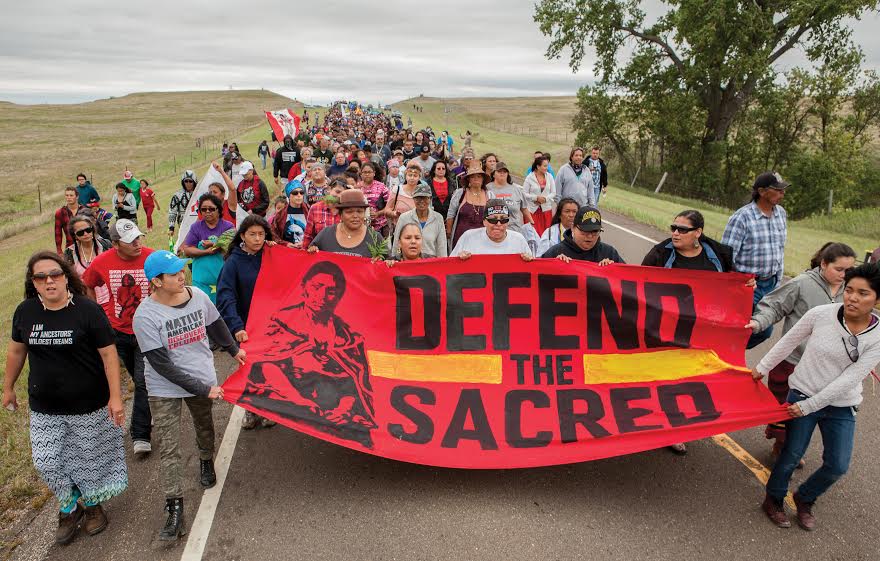PROTEST: The Sioux tribe claims a victory with their protests, which argue for more than just an oil pipeline.
By Ernie Mendez, Staff Writer
On January 25, 2016, Dakota Access Limited Liability Company (LLC), a subsidiary of Energy Transfer Partners responsible for transporting crude oil in the North Dakota area also led the Dakota Access Pipeline project. After receiving preliminary permit approval, they began implementing the crude oil pipeline across four states including: North Dakota, South Dakota, Iowa and Illinois.
On July 27, 2016, attorneys representing the Standing Rock Sioux Tribe took legal action in the courts where they filed a complaint against the United States Army Corps of Engineers (USACE) for granting permission to Dakota Access LLC to construct of the pipeline. Following the lawsuit, several protests began. The protesters included members of the Standing Rock Sioux Tribe, as well as different activist groups and several hundred veterans who planned to serve as “human-shields.” They endured tear gas, rubber bullets, attack dogs and water cannons in below-freezing temperatures. Throughout the protests, some saw the demonstrations as violent and unnecessary. Some conservatives, including President-Elect Donald Trump and commentator Tomi Lahren showed support for the pipeline’s construction. Sheriffs also claimed the protesters to be aggressive and behaving like rioters rather than protesters. This is far from reality, and those in favor of the pipeline do not realize that the Sioux Tribe is fighting for their rights, their water and their culture. The Standing Rock Sioux Tribe was primarily defending their main source of water, and these tactics only bring Native American oppression to the cultural forefront of American society. On December 4, 2016, the USACE announced that it would be rerouting the pipeline, and the protesters began to celebrate. These demonstrations proved to be a success, showing the power of voice and protests, which can be used as positive vehicles of change.
One of the most controversial aspects of the Dakota Access Pipeline protests was the reliability of the oil pipeline and its potential to leak into the Missouri River. Many protesters’ signs read, “water is life,” since the pipeline was built right under the tribe’s primary source of drinking water. Many supporters of the pipeline claimed that the pipeline was mostly safe, reliable and able to create more jobs. However, environmentalists argued that the oil pipeline was not as safe as many thought. An article from Time, written by Justin Worland, explains that “the Pipeline and Hazardous Materials Safety Administration (PHMSA) has reported more than 3,300 incidents of leaks and ruptures at oil and gas pipelines since 2010. And even the smallest spill could damage the tribe’s water supply.”
The Sioux tribe made a very good decision to protest the pipeline; an article written by journalist Tom DiChristopher reported, on December 5, 2016, that “a pipeline leak has spilled tens of thousands of crude oil into a North Dakota Creek roughly two and a half hours from Cannon Ball, where protesters [were] camped out in opposition of the Dakota Access pipeline.” It is clear that oil leaking into the Sioux Tribe’s water supply was a likely possibility.
Another problem with the construction of the oil pipeline is that the Sioux Tribe considers the potential location of the pipeline to be sacred tribal ground. It is considered a sacred burial ground of the Sioux nation, and the Sioux wish to keep the site undisturbed. Native Americans should not have to fight for the rights of their original land. Yet, they endured a long fight for their rights to clean water. Sadly, Native Americans have been an oppressed group for a long time in the United States of America. The discrimination is still prevalent, from a National Football League team with the offensive name of “Redskins” to a holiday that celebrates Christopher Columbus, a man who “discovered” a land that was settled upon long before he arrived and brought the genocide of indigenous people. Incidents like the Dakota Access Pipeline help shed light on the oppression of Native Americans, and it opens discussion for very relevant topics of discrimination in our society. Poly Students also agree with the protests; “I agree with how they protested against the oil pipeline. [Their land] should not be invaded by other people,” Kenya Ortiz (12) said.
Finally, the pipeline saw many people from different backgrounds come together to support the indigenous people. Discussion of the pipeline was trending on social media; journalists covered the topic, opening events to the overall treatment and rights of the Native Americans. Perhaps the most heartwarming, inspiring and emotional event to occur was a video that was released starring Wesley Clark Jr., the son of a retired U.S. army General Wesley Clark Sr., along with a group of veterans, kneeling before the chief of the Standing Rock Sioux Tribe and asking for forgiveness. In the video, he exclaims, “We didn’t respect you, we polluted your earth, we’ve hurt you in so many ways, but we’ve come to say that we are sorry. We are at your service, and we beg for your forgiveness.”
The Sioux Tribe showcased the power of protesting injustice. The best way to solve a problem is to address the problem, not ignore it. A solution cannot be found for a problem that has not been identified first. After the problem of discrimination is identified in this country, we can then discuss how minority groups in general can be helped in order to be treated fairly. We can learn how to stop systemic racism and at that point, we can continually work towards a nation that truly believes and practices the idea that all men are created equal.

